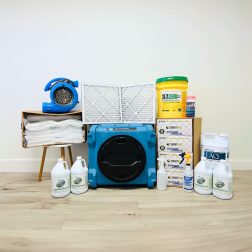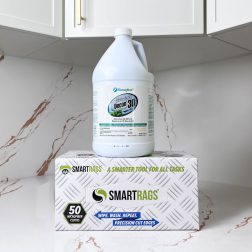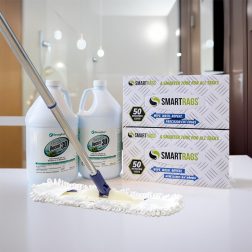No products in the cart.
Mold Resources
“What causes mold in a house during winter,” is a great question. Here are a few routes where winter weather can rain on your healthy home parade. Most of these include moisture intrusion into the home and some practices we implement during the colder months.
7 Answers to What Causes Mold in a House During Winter
1. Ice Dams
Snow on a roof can give your home that picture-perfect postcard aesthetic but can also lead to issues as precipitation melts. The heat from the interior of the home or higher temperatures during the day can slowly thaw that blanket of snow, resulting in a downward trickle of moisture toward the gutter system.
The colder temperatures of the gutter or the freezing temperatures around nightfall can lead to water freezing, where the issues begin to occur. As the ice builds up and expands, it can damage the walls, roof, and gutters. Each scenario leads to moisture intrusion into the home and an indoor contamination opportunity.
Pro tip: A buildup of ice along the eaves or an abundance of ice cycles can indicate an ice dam situation.
2. Snow and Ice Melt
Speaking of melting precipitation, this natural process can also lead to issues for the foundation of the home.
As the snow melts during the day, moisture will permeate the soil and build up. This is an issue for a couple of reasons. Oversaturation of the soil can lead to moisture intrusion into any cracks, holes, or porous surfaces in the home’s foundation. It can also create added weight against the home’s foundation, leading to cracks and other structural issues.
Refreezing is the other piece of the puzzle that can cause problems. As the temperature fluctuates back to freezing at night, any moisture that makes its way into cracks or other areas will turn into ice and expand. This growth will further exacerbate the current foundational issues, creating more room for moisture to intrude indoors.
Not to mention, the newly formed ice causes the soil to expand, pushing against the home's foundation. This back-and-forth of expansion and compression can result in structural issues for the building, such as cracks or shifting in the foundation. This is one of the top reasons for what causes mold in a house during winter.
3. Frost Heave
Piggybacking off of this, icy soil can trigger another effect called frost heaving. This is a particular concern in areas where the temperature stays below freezing for some time because the cold air can permeate deep within the soil, creating more opportunities for ice lenses to form and deepen.
The melted snow and ice in the soil will freeze and create ice pockets. That ice will expand up to 9%, causing the soil to swell. The larger the ice pocket is, the more it will push the soil upwards. From there, any melted precipitation can then be added to this ice increase in the soil when the temperatures drop back to freezing.
This expansion shifts the soil surface, which forces parts of the home’s foundation up. As you can imagine, that can cause a long list of structural issues to the building.
4. Tree Damage
Snow-laden trees can look beautiful but quickly become a home health hazard.
Limbs weighed down with snow and ice can result in drooping, allowing them to scratch or hit the home's exterior. Over time, this can lead to pathways for moisture intrusion. The additional weight from the snow and ice can also lead to branches breaking and falling on a home, creating even more damage. This results in more money spent repairing the snow damage and more opportunities for moisture intrusion and microbial growth.
Heavy snow and ice can sometimes cause entire trees to fall. This can cause widespread damage to a home and severe moisture intrusion. This is another main reason for what causes mold in a house during winter.
5. Excess Weight on Roof
That fluffy snow may not look like a problem, but it’s not as weightless as it appears.
As snow accumulates over time, this buildup's weight will also increase. And that’s not even considering the ice that can also form on the surface. This can put significant stress on the roof. If other issues, such as poor design, improper construction, or lack of maintenance, come into the mix, that snow blanket can lead to roof collapse.
The rule of thumb is that 4 feet of fresh snow and 2 feet of packed snow can begin to put a serious strain on a roof.
While this isn’t a comprehensive list of the leading causes of snow damage to a home, these are the top situations to look out for and work to prevent.
6. Humidity Fluctuations
During the winter, there can be issues with humidity in the home. Ideal humidity levels in a home should be between 35-50%. Some species of mold can begin to grow in areas with high humidity. This moisture-rich air can cause condensation as it hits warm surfaces, creating another opportunity for microbial growth. Some spores can transition into an active colony in 24-48 hours on a surface with food and moisture.
On the other hand, levels that are too low can cause structural issues in a home, particularly with wooden surfaces. Hence, it’s important to maintain that perfect sweet spot.
Investing in a hygrometer and continually monitoring indoor humidity levels is great. If it goes too far in either direction, you can jump into action to fix it and ensure your environment remains safe. If they widely fluctuate and you have no idea why, there may be a larger problem at home, such as structural issues. In this case, contact an expert for their input on the issue to resolve it ASAP.
Check out this article for tips on maintaining the ideal indoor humidity level.
7. Humidifier Neglect
What causes mold in a house during winter and poor indoor air quality? A dirty humidifier. When the weather is cold and dry, these are often used in homes to increase the humidity. However, they can be huge sources of contamination if they’re not properly maintained.
Cleaning humidifiers ensures you’re not blowing contaminants into the home. These machines are prone to develop microbial growth thanks to water usage and organic matter such as mineral deposits. Once inside, that growth will release microscopic particles like mold spores, exotoxins, mycotoxins, and more. When the machine is turned on, all those particles will be released into the room, lowering the indoor air quality and causing unwanted exposure. Keeping it clean will help prevent microbial growth from developing and contaminating the indoor space.
The EPA suggests that you clean a humidifier every three days or so. The cleaner they are, the less likely they will release contaminants into the air, causing unwanted exposure.
Only use a humidifier when necessary, and as long as the indoor humidity remains between 35-50%.
For steps on how to prevent mold in the winter and promote healthy indoor air quality, check out this article.
Showing all 3 results
-

HomeCleanse DIY
All the equipment and materials we use to remediate your home, plus consultation and support...
-
$5,995.00 – $9,995.00 SHOP NOW -

Mold & Bacteria Contents Cleaning
Remove harmful pollutants that accumulate in the dust of your home. (Options available for renters...
-
$99.00 – $349.00 SHOP NOW -

HomeCleanse Cleaning
Take your cleaning to the next level buying all the tools we use to keep...
-
$299.00 – $549.00 SHOP NOW
Still Have Questions?
A member of our team is here to help! Click on “Get Started ➤” below to book a consultation with a member of the HOMECLEANSE team. We have a few quick questions that will help us put together a roadmap to solve or prevent all of your mold problems.
Two minutes of your time could lead to better health for you and your family.
